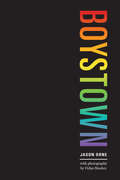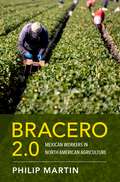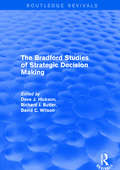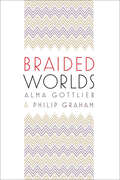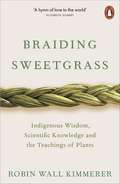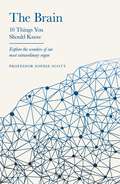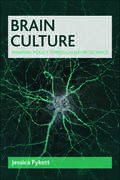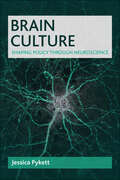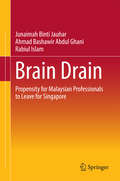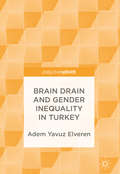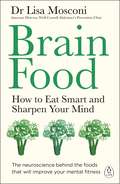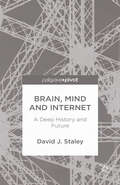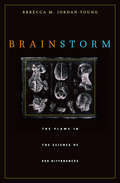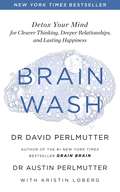- Table View
- List View
Boystown: Sex and Community in Chicago
by Jason OrneFrom neighborhoods as large as Chelsea or the Castro, to locales limited to a single club, like The Shamrock in Madison or Sidewinders in Albuquerque, gay areas are becoming normal. Straight people flood in. Gay people flee out. Scholars call this transformation assimilation, and some argue that we—gay and straight alike—are becoming “post-gay.” Jason Orne argues that rather than post-gay, America is becoming “post-queer,” losing the radical lessons of sex. In Boystown, Orne takes readers on a detailed, lively journey through Chicago’s Boystown, which serves as a model for gayborhoods around the country. The neighborhood, he argues, has become an entertainment district—a gay Disneyland—where people get lost in the magic of the night and where straight white women can “go on safari.” In their original form, though, gayborhoods like this one don’t celebrate differences; they create them. By fostering a space outside the mainstream, gay spaces allow people to develop an alternative culture—a queer culture that celebrates sex. Orne spent three years doing fieldwork in Boystown, searching for ways to ask new questions about the connective power of sex and about what it means to be not just gay, but queer. The result is the striking Boystown, illustrated throughout with street photography by Dylan Stuckey. In the dark backrooms of raunchy clubs where bachelorettes wouldn’t dare tread, people are hooking up and forging “naked intimacy.” Orne is your tour guide to the real Boystown, then, where sex functions as a vital center and an antidote to assimilation.
Boystown: Sex and Community in Chicago
by Jason OrneFrom neighborhoods as large as Chelsea or the Castro, to locales limited to a single club, like The Shamrock in Madison or Sidewinders in Albuquerque, gay areas are becoming normal. Straight people flood in. Gay people flee out. Scholars call this transformation assimilation, and some argue that we—gay and straight alike—are becoming “post-gay.” Jason Orne argues that rather than post-gay, America is becoming “post-queer,” losing the radical lessons of sex. In Boystown, Orne takes readers on a detailed, lively journey through Chicago’s Boystown, which serves as a model for gayborhoods around the country. The neighborhood, he argues, has become an entertainment district—a gay Disneyland—where people get lost in the magic of the night and where straight white women can “go on safari.” In their original form, though, gayborhoods like this one don’t celebrate differences; they create them. By fostering a space outside the mainstream, gay spaces allow people to develop an alternative culture—a queer culture that celebrates sex. Orne spent three years doing fieldwork in Boystown, searching for ways to ask new questions about the connective power of sex and about what it means to be not just gay, but queer. The result is the striking Boystown, illustrated throughout with street photography by Dylan Stuckey. In the dark backrooms of raunchy clubs where bachelorettes wouldn’t dare tread, people are hooking up and forging “naked intimacy.” Orne is your tour guide to the real Boystown, then, where sex functions as a vital center and an antidote to assimilation.
Boystown: Sex and Community in Chicago
by Jason OrneFrom neighborhoods as large as Chelsea or the Castro, to locales limited to a single club, like The Shamrock in Madison or Sidewinders in Albuquerque, gay areas are becoming normal. Straight people flood in. Gay people flee out. Scholars call this transformation assimilation, and some argue that we—gay and straight alike—are becoming “post-gay.” Jason Orne argues that rather than post-gay, America is becoming “post-queer,” losing the radical lessons of sex. In Boystown, Orne takes readers on a detailed, lively journey through Chicago’s Boystown, which serves as a model for gayborhoods around the country. The neighborhood, he argues, has become an entertainment district—a gay Disneyland—where people get lost in the magic of the night and where straight white women can “go on safari.” In their original form, though, gayborhoods like this one don’t celebrate differences; they create them. By fostering a space outside the mainstream, gay spaces allow people to develop an alternative culture—a queer culture that celebrates sex. Orne spent three years doing fieldwork in Boystown, searching for ways to ask new questions about the connective power of sex and about what it means to be not just gay, but queer. The result is the striking Boystown, illustrated throughout with street photography by Dylan Stuckey. In the dark backrooms of raunchy clubs where bachelorettes wouldn’t dare tread, people are hooking up and forging “naked intimacy.” Orne is your tour guide to the real Boystown, then, where sex functions as a vital center and an antidote to assimilation.
Boystown: Sex and Community in Chicago
by Jason OrneFrom neighborhoods as large as Chelsea or the Castro, to locales limited to a single club, like The Shamrock in Madison or Sidewinders in Albuquerque, gay areas are becoming normal. Straight people flood in. Gay people flee out. Scholars call this transformation assimilation, and some argue that we—gay and straight alike—are becoming “post-gay.” Jason Orne argues that rather than post-gay, America is becoming “post-queer,” losing the radical lessons of sex. In Boystown, Orne takes readers on a detailed, lively journey through Chicago’s Boystown, which serves as a model for gayborhoods around the country. The neighborhood, he argues, has become an entertainment district—a gay Disneyland—where people get lost in the magic of the night and where straight white women can “go on safari.” In their original form, though, gayborhoods like this one don’t celebrate differences; they create them. By fostering a space outside the mainstream, gay spaces allow people to develop an alternative culture—a queer culture that celebrates sex. Orne spent three years doing fieldwork in Boystown, searching for ways to ask new questions about the connective power of sex and about what it means to be not just gay, but queer. The result is the striking Boystown, illustrated throughout with street photography by Dylan Stuckey. In the dark backrooms of raunchy clubs where bachelorettes wouldn’t dare tread, people are hooking up and forging “naked intimacy.” Orne is your tour guide to the real Boystown, then, where sex functions as a vital center and an antidote to assimilation.
Boystown: Sex and Community in Chicago
by Jason OrneFrom neighborhoods as large as Chelsea or the Castro, to locales limited to a single club, like The Shamrock in Madison or Sidewinders in Albuquerque, gay areas are becoming normal. Straight people flood in. Gay people flee out. Scholars call this transformation assimilation, and some argue that we—gay and straight alike—are becoming “post-gay.” Jason Orne argues that rather than post-gay, America is becoming “post-queer,” losing the radical lessons of sex. In Boystown, Orne takes readers on a detailed, lively journey through Chicago’s Boystown, which serves as a model for gayborhoods around the country. The neighborhood, he argues, has become an entertainment district—a gay Disneyland—where people get lost in the magic of the night and where straight white women can “go on safari.” In their original form, though, gayborhoods like this one don’t celebrate differences; they create them. By fostering a space outside the mainstream, gay spaces allow people to develop an alternative culture—a queer culture that celebrates sex. Orne spent three years doing fieldwork in Boystown, searching for ways to ask new questions about the connective power of sex and about what it means to be not just gay, but queer. The result is the striking Boystown, illustrated throughout with street photography by Dylan Stuckey. In the dark backrooms of raunchy clubs where bachelorettes wouldn’t dare tread, people are hooking up and forging “naked intimacy.” Orne is your tour guide to the real Boystown, then, where sex functions as a vital center and an antidote to assimilation.
Bracero 2.0: Mexican Workers in North American Agriculture
by Philip MartinRising consumer demand for fresh fruits and vegetables has led to the employment of five million Mexican-born workers on North American farms during a typical year. The migration of Mexican workers within and from Mexico has implications for North American agriculture, labor, and economic development. For instance, the guest worker systems of Canada and the US allow Mexican workers to earn five times more in six months than they could earn in a year at home, fueling the construction of trophy homes in rural Mexico but not necessarily spurring economic development. The expansion of export agriculture encourages internal migration from south-to-north within Mexico, which moves migrants to areas that offer higher wages but may subject some migrants to exploitation. In Bracero 2.0, Philip Martin draws on decades of research and experience to explore the role of rural Mexicans in North American agriculture, as well as the implications for farm employers and farm workers, consumers, and the economies of North America. Martin assesses the historical and current demand for and supply of farm labor and the operation of farm labor markets in Canada, Mexico, and the US. He also uses statistical and survey data to provide the most reliable portrait of the five million people who work for wages on North American farms and explores alternatives to US farm workers in major fruits and vegetables, showing how changing consumer preferences can speed or slow mechanization. Bracero 2.0 concludes with options to improve protections for farm workers, highlighting the need for systems that ensure continuous labor law compliance--as with food safety--rather than compliance only for government or private audits.
Bracero 2.0: Mexican Workers in North American Agriculture
by Philip MartinRising consumer demand for fresh fruits and vegetables has led to the employment of five million Mexican-born workers on North American farms during a typical year. The migration of Mexican workers within and from Mexico has implications for North American agriculture, labor, and economic development. For instance, the guest worker systems of Canada and the US allow Mexican workers to earn five times more in six months than they could earn in a year at home, fueling the construction of trophy homes in rural Mexico but not necessarily spurring economic development. The expansion of export agriculture encourages internal migration from south-to-north within Mexico, which moves migrants to areas that offer higher wages but may subject some migrants to exploitation. In Bracero 2.0, Philip Martin draws on decades of research and experience to explore the role of rural Mexicans in North American agriculture, as well as the implications for farm employers and farm workers, consumers, and the economies of North America. Martin assesses the historical and current demand for and supply of farm labor and the operation of farm labor markets in Canada, Mexico, and the US. He also uses statistical and survey data to provide the most reliable portrait of the five million people who work for wages on North American farms and explores alternatives to US farm workers in major fruits and vegetables, showing how changing consumer preferences can speed or slow mechanization. Bracero 2.0 concludes with options to improve protections for farm workers, highlighting the need for systems that ensure continuous labor law compliance--as with food safety--rather than compliance only for government or private audits.
The Bradford Studies of Strategic Decision Making
by David J. Hickson, Richard J. Butler and David C. WilsonThis title was first published in 2001. This volume brings together the 25-year output of the longest running programme of research into the making of decisions by top management. It describes and explains the processes of arriving at major decisions and how they are affected by the issue under decision, the form of organization and national differences and then, finally, success and failure in implementation. The programme continues with research on routes in successfully managing implementation.
The Bradford Studies of Strategic Decision Making
by Dave J. Hickson Richard J. Butler David C. WilsonThis title was first published in 2001. This volume brings together the 25-year output of the longest running programme of research into the making of decisions by top management. It describes and explains the processes of arriving at major decisions and how they are affected by the issue under decision, the form of organization and national differences and then, finally, success and failure in implementation. The programme continues with research on routes in successfully managing implementation.
Braided Worlds
by Alma Gottlieb Philip GrahamIn a compelling mix of literary narrative and ethnography, anthropologist Alma Gottlieb and writer Philip Graham continue the long journey of cultural engagement with the Beng people of Côte d’Ivoire that they first recounted in their award-winning memoir Parallel Worlds. Their commitment over the span of several decades has lent them a rare insight. Braiding their own stories with those of the villagers of Asagbé and Kosangbé, Gottlieb and Graham take turns recounting a host of unexpected dramas with these West African villages, prompting serious questions about the fraught nature of cultural contact. Through events such as a religious leader’s declaration that the authors’ six-year-old son, Nathaniel, is the reincarnation of a revered ancestor, or Graham’s late father being accepted into the Beng afterlife, or the increasing, sometimes dangerous madness of a villager, the authors are forced to reconcile their anthropological and literary gaze with the deepest parts of their personal lives. Along with these intimate dramas, they follow the Beng from times of peace through the times of tragedy that led to Côte d’Ivoire’s recent civil conflicts. From these and many other interweaving narratives—and with the combined strengths of an anthropologist and a literary writer—Braided Worlds examines the impact of postcolonialism, race, and global inequity at the same time that it chronicles a living, breathing village community where two very different worlds meet.
Braided Worlds
by Alma Gottlieb Philip GrahamIn a compelling mix of literary narrative and ethnography, anthropologist Alma Gottlieb and writer Philip Graham continue the long journey of cultural engagement with the Beng people of Côte d’Ivoire that they first recounted in their award-winning memoir Parallel Worlds. Their commitment over the span of several decades has lent them a rare insight. Braiding their own stories with those of the villagers of Asagbé and Kosangbé, Gottlieb and Graham take turns recounting a host of unexpected dramas with these West African villages, prompting serious questions about the fraught nature of cultural contact. Through events such as a religious leader’s declaration that the authors’ six-year-old son, Nathaniel, is the reincarnation of a revered ancestor, or Graham’s late father being accepted into the Beng afterlife, or the increasing, sometimes dangerous madness of a villager, the authors are forced to reconcile their anthropological and literary gaze with the deepest parts of their personal lives. Along with these intimate dramas, they follow the Beng from times of peace through the times of tragedy that led to Côte d’Ivoire’s recent civil conflicts. From these and many other interweaving narratives—and with the combined strengths of an anthropologist and a literary writer—Braided Worlds examines the impact of postcolonialism, race, and global inequity at the same time that it chronicles a living, breathing village community where two very different worlds meet.
Braided Worlds
by Alma Gottlieb Philip GrahamIn a compelling mix of literary narrative and ethnography, anthropologist Alma Gottlieb and writer Philip Graham continue the long journey of cultural engagement with the Beng people of Côte d’Ivoire that they first recounted in their award-winning memoir Parallel Worlds. Their commitment over the span of several decades has lent them a rare insight. Braiding their own stories with those of the villagers of Asagbé and Kosangbé, Gottlieb and Graham take turns recounting a host of unexpected dramas with these West African villages, prompting serious questions about the fraught nature of cultural contact. Through events such as a religious leader’s declaration that the authors’ six-year-old son, Nathaniel, is the reincarnation of a revered ancestor, or Graham’s late father being accepted into the Beng afterlife, or the increasing, sometimes dangerous madness of a villager, the authors are forced to reconcile their anthropological and literary gaze with the deepest parts of their personal lives. Along with these intimate dramas, they follow the Beng from times of peace through the times of tragedy that led to Côte d’Ivoire’s recent civil conflicts. From these and many other interweaving narratives—and with the combined strengths of an anthropologist and a literary writer—Braided Worlds examines the impact of postcolonialism, race, and global inequity at the same time that it chronicles a living, breathing village community where two very different worlds meet.
Braided Worlds
by Alma Gottlieb Philip GrahamIn a compelling mix of literary narrative and ethnography, anthropologist Alma Gottlieb and writer Philip Graham continue the long journey of cultural engagement with the Beng people of Côte d’Ivoire that they first recounted in their award-winning memoir Parallel Worlds. Their commitment over the span of several decades has lent them a rare insight. Braiding their own stories with those of the villagers of Asagbé and Kosangbé, Gottlieb and Graham take turns recounting a host of unexpected dramas with these West African villages, prompting serious questions about the fraught nature of cultural contact. Through events such as a religious leader’s declaration that the authors’ six-year-old son, Nathaniel, is the reincarnation of a revered ancestor, or Graham’s late father being accepted into the Beng afterlife, or the increasing, sometimes dangerous madness of a villager, the authors are forced to reconcile their anthropological and literary gaze with the deepest parts of their personal lives. Along with these intimate dramas, they follow the Beng from times of peace through the times of tragedy that led to Côte d’Ivoire’s recent civil conflicts. From these and many other interweaving narratives—and with the combined strengths of an anthropologist and a literary writer—Braided Worlds examines the impact of postcolonialism, race, and global inequity at the same time that it chronicles a living, breathing village community where two very different worlds meet.
Braided Worlds
by Alma Gottlieb Philip GrahamIn a compelling mix of literary narrative and ethnography, anthropologist Alma Gottlieb and writer Philip Graham continue the long journey of cultural engagement with the Beng people of Côte d’Ivoire that they first recounted in their award-winning memoir Parallel Worlds. Their commitment over the span of several decades has lent them a rare insight. Braiding their own stories with those of the villagers of Asagbé and Kosangbé, Gottlieb and Graham take turns recounting a host of unexpected dramas with these West African villages, prompting serious questions about the fraught nature of cultural contact. Through events such as a religious leader’s declaration that the authors’ six-year-old son, Nathaniel, is the reincarnation of a revered ancestor, or Graham’s late father being accepted into the Beng afterlife, or the increasing, sometimes dangerous madness of a villager, the authors are forced to reconcile their anthropological and literary gaze with the deepest parts of their personal lives. Along with these intimate dramas, they follow the Beng from times of peace through the times of tragedy that led to Côte d’Ivoire’s recent civil conflicts. From these and many other interweaving narratives—and with the combined strengths of an anthropologist and a literary writer—Braided Worlds examines the impact of postcolonialism, race, and global inequity at the same time that it chronicles a living, breathing village community where two very different worlds meet.
Braided Worlds
by Alma Gottlieb Philip GrahamIn a compelling mix of literary narrative and ethnography, anthropologist Alma Gottlieb and writer Philip Graham continue the long journey of cultural engagement with the Beng people of Côte d’Ivoire that they first recounted in their award-winning memoir Parallel Worlds. Their commitment over the span of several decades has lent them a rare insight. Braiding their own stories with those of the villagers of Asagbé and Kosangbé, Gottlieb and Graham take turns recounting a host of unexpected dramas with these West African villages, prompting serious questions about the fraught nature of cultural contact. Through events such as a religious leader’s declaration that the authors’ six-year-old son, Nathaniel, is the reincarnation of a revered ancestor, or Graham’s late father being accepted into the Beng afterlife, or the increasing, sometimes dangerous madness of a villager, the authors are forced to reconcile their anthropological and literary gaze with the deepest parts of their personal lives. Along with these intimate dramas, they follow the Beng from times of peace through the times of tragedy that led to Côte d’Ivoire’s recent civil conflicts. From these and many other interweaving narratives—and with the combined strengths of an anthropologist and a literary writer—Braided Worlds examines the impact of postcolonialism, race, and global inequity at the same time that it chronicles a living, breathing village community where two very different worlds meet.
Braiding Sweetgrass: Indigenous Wisdom, Scientific Knowledge and the Teachings of Plants
by Robin Wall Kimmerer'A hymn of love to the world ... A journey that is every bit as mythic as it is scientific, as sacred as it is historical, as clever as it is wise' Elizabeth Gilbert, author of Eat, Pray, LoveAs a botanist, Robin Wall Kimmerer has been trained to ask questions of nature with the tools of science. As a member of the Citizen Potawatomi Nation, she embraces the notion that plants and animals are our oldest teachers. In Braiding Sweetgrass, Kimmerer brings these two ways of knowledge together. Drawing on her life as an indigenous scientist, a mother, and a woman, Kimmerer shows how other living beings - asters and goldenrod, strawberries and squash, salamanders, algae, and sweetgrass - offer us gifts and lessons, even if we've forgotten how to hear their voices. In a rich braid of reflections that range from the creation of Turtle Island to the forces that threaten its flourishing today, she circles toward a central argument: that the awakening of a wider ecological consciousness requires the acknowledgment and celebration of our reciprocal relationship with the rest of the living world. For only when we can hear the languages of other beings will we be capable of understanding the generosity of the earth, and learn to give our own gifts in return.
The Brain: 10 Things You Should Know
by Professor Sophie ScottUncover the mind-blowing complexities of the brain and how it affects our personalities, behaviours and more.Written by Professor of Cognitive Neuroscience at UCL, Sophie Scott, and composed of ten mind-blowing yet accessible essays, The Brain guides you through the astounding complexities of the organ that makes you, you. From diving into the networks of neurons that are vital to our functioning, to the way our brains differ from one another and how neuroscience is shaping up for the future; this book is a guide to our most powerful and awe-inspiring body part.If you have ever wondered what's going on inside your head (or someone else's), this book will be a fascinating and enthralling read.
Brain culture: Shaping policy through neuroscience
by Jessica PykettThis unique book offers a timely analysis of the impact of rapidly advancing knowledge about the brain, mind and behaviour on contemporary public policy and practice. Examining developments in behaviour change policies, neuroscience, architecture and urban design, education, and workplace training programmes the book analyses the global spread of research agendas, policy experiments and everyday practice informed by ‘brain culture’. It offers an alternative, geographically informed set of explanations for what matters in explaining how people behave and how citizens’ behaviour should be governed. It will be of interest to students and academics across the social and behavioural sciences.
Brain culture: Shaping policy through neuroscience
by Jessica PykettThis unique book offers a timely analysis of the impact of rapidly advancing knowledge about the brain, mind and behaviour on contemporary public policy and practice. Examining developments in behaviour change policies, neuroscience, architecture and urban design, education, and workplace training programmes the book analyses the global spread of research agendas, policy experiments and everyday practice informed by ‘brain culture’. It offers an alternative, geographically informed set of explanations for what matters in explaining how people behave and how citizens’ behaviour should be governed. It will be of interest to students and academics across the social and behavioural sciences.
Brain Drain: Propensity for Malaysian Professionals to Leave for Singapore (Springerbriefs In Economics Ser.)
by Junaimah Binti Jauhar Ahmad Bashawir Abdul Ghani Rabiul IslamThis book focuses on skilled labour migration from Malaysia to Singapore. In this regard, it examines a number of variables such as Better Perks and Benefits, Quality of Work Life, Ease of Immigration Procedures, International Exposure, Greater Job Availability, and Social Networks, and how they influence the decisions of Malaysian accounting professionals.In doing so, the book elaborates on how this phenomenon is an indirect result of globalization, which is predominantly detrimental for developing countries such as Malaysia.The book also highlights the need for these experts in their home country, as Malaysia is currently striving to improve its economy in order to achieve high-income status by 2020.
Brain Drain and Gender Inequality in Turkey
by Adem Yavuz ElverenThis book provides a comprehensive analysis of the brain drain from Turkey, with particular focus on its gender dimension. The author presents a review of brain drain literature, as well as analyzing the brain drain from Turkey using original survey data. Presenting an account of state changes in Turkey, and using a range of empirical methods, the book argues that women have a higher tendency not to return to the country due to increasing gender inequality, borne out of a shift towards a more authoritarian regime over the last decade. Brain Drain and Gender Inequality in Turkey will be of interest to students and scholars across a range of disciplines, including migration studies, social policy, and gender studies.
Brain Food: How to Eat Smart and Sharpen Your Mind
by Dr Lisa MosconiA call to action to prevent a brain health crisis - does for diet what Why We Sleep does for sleep 'One of the most exciting reads on brain health that I have ever come across ... I cannot recommend this book enough' - Dr Rupy Aujla, author of The Doctor's KitchenWe often talk about how our diets affect our fitness - but we don't discuss how they affect the hungriest organ in the body, the brain. And it has surprising dietary needs that differ from the rest of our body. Brain Food uses cutting-edge research to highlight the connection between nutrition and our brain's health, busting through pseudoscience and demonstrating how we can all change our diet most effectively. Based partly on her own discoveries, and using emerging science, for example on the connection between the brain and the gut, Dr Lisa Mosconi, an expert in both neuroscience and nutrition, reveals the foods and drinks that can prevent dementia, stress, cognitive decline and memory loss - no matter how old we are. Innovative and timely, and with accompanying brain-boosting recipes and lists of what to eat and what to avoid, Brain Food provides the ultimate plan for maximising our brain power. 'A critically important book. If you want to keep and save your brain you have to get your food right. Brain Food will help you do just that in a delicious, easy way' - Daniel G. Amen, author of Memory Rescue
Brain, Mind and Internet: A Deep History and Future
by D. StaleyThis essay places the emerging brain-Internet interface within a broad historical context: that the Internet represents merely the next stage in a very long history of human cognition whereby the brain couples with symbolic technologies. Understanding this 'deep history' provides a way to imagine the future of brain-Internet cognition.
Brain Storm: The Flaws in the Science of Sex Differences
by Rebecca M. Jordan-YoungFemale and male brains are different, thanks to hormones coursing through the brain before birth. That’s taught as fact in psychology textbooks, academic journals, and bestselling books. And these hardwired differences explain everything from sexual orientation to gender identity, to why there aren’t more women physicists or more stay-at-home dads. In this compelling book, Rebecca Jordan-Young takes on the evidence that sex differences are hardwired into the brain. Analyzing virtually all published research that supports the claims of “human brain organization theory,” Jordan-Young reveals how often these studies fail the standards of science. Even if careful researchers point out the limits of their own studies, other researchers and journalists can easily ignore them because brain organization theory just sounds so right. But if a series of methodological weaknesses, questionable assumptions, inconsistent definitions, and enormous gaps between ambiguous findings and grand conclusions have accumulated through the years, then science isn’t scientific at all. Elegantly written, this book argues passionately that the analysis of gender differences deserves far more rigorous, biologically sophisticated science. “The evidence for hormonal sex differentiation of the human brain better resembles a hodge-podge pile than a solid structure…Once we have cleared the rubble, we can begin to build newer, more scientific stories about human development.”
Brain Wash: Detox Your Mind for Clearer Thinking, Deeper Relationships and Lasting Happiness
by David PerlmutterThe #1 New York Times bestselling author of Grain Brain and his physician son explore how modern culture threatens to rewire our brains and damage our health, offering a practical plan for healing. Contemporary life provides us with infinite opportunities, along with endless temptations. We can eat whatever we want, whenever we want. We can immerse ourselves in the vast, enticing world of digital media. We can buy goods and services with the touch of a button or the swipe of a finger. But living in this 24/7 hyper-reality poses serious risks to our physical and mental states, our connections to others and even to the world at large. Brain Wash builds from a simple premise: Our brains are being gravely manipulated, resulting in behaviours that leave us more lonely, anxious, depressed, distrustful, illness-prone and overweight than ever before. Based on the latest science, the book identifies the mental hijacking that undermines each and every one of us and presents the tools necessary to think more clearly, make better decisions, strengthen bonds with others and develop healthier habits. Featuring a 10-day boot camp program, including a meal plan and 40 delicious recipes, Brain Wash is the key to cultivating a more purposeful and fulfilling life.'By showing us how to consciously rewire our brains for connection, compassion, and better decisions, Brain Wash provides a framework for reclaiming joy and health in the modern world.' - Deepak Chopra, author of Metahuman'Brain Wash reveals how our day-to-day decisions are deeply influenced and actively manipulated by the modern world. But more importantly, it is a powerful manual that allows each of us to reclaim control of our choices and make better decisions that will pave the way for health and happiness. While we generally know what's best for ourselves, acting on this knowledge is a constant struggle. Brain Wash allows us to turn this knowledge into action. I highly recommend this innovative book.'- Daniel G. Amen, MD, founder, Amen Clinics and author of The End of Mental Illness
